Safety and Health Client Based Study: Case of Singapore Power Cable Tunnel Project
VerifiedAdded on 2023/06/12
|13
|3883
|499
AI Summary
This study focuses on the health and safety policy measures undertaken by SP Group management in the Singapore power cable tunnel project. It covers the detailed timing plan, analysis of progress, discussion surrounding any product of value realized by the work, and how each of the four learning outcomes were met in relation to the study.
Contribute Materials
Your contribution can guide someone’s learning journey. Share your
documents today.

CBS 1
Safety and Health Client Based Study
Case of Singapore power cable tunnel project
Student Name:
Student Number:
Module Code:
Submission Date:
Safety and Health Client Based Study
Case of Singapore power cable tunnel project
Student Name:
Student Number:
Module Code:
Submission Date:
Secure Best Marks with AI Grader
Need help grading? Try our AI Grader for instant feedback on your assignments.
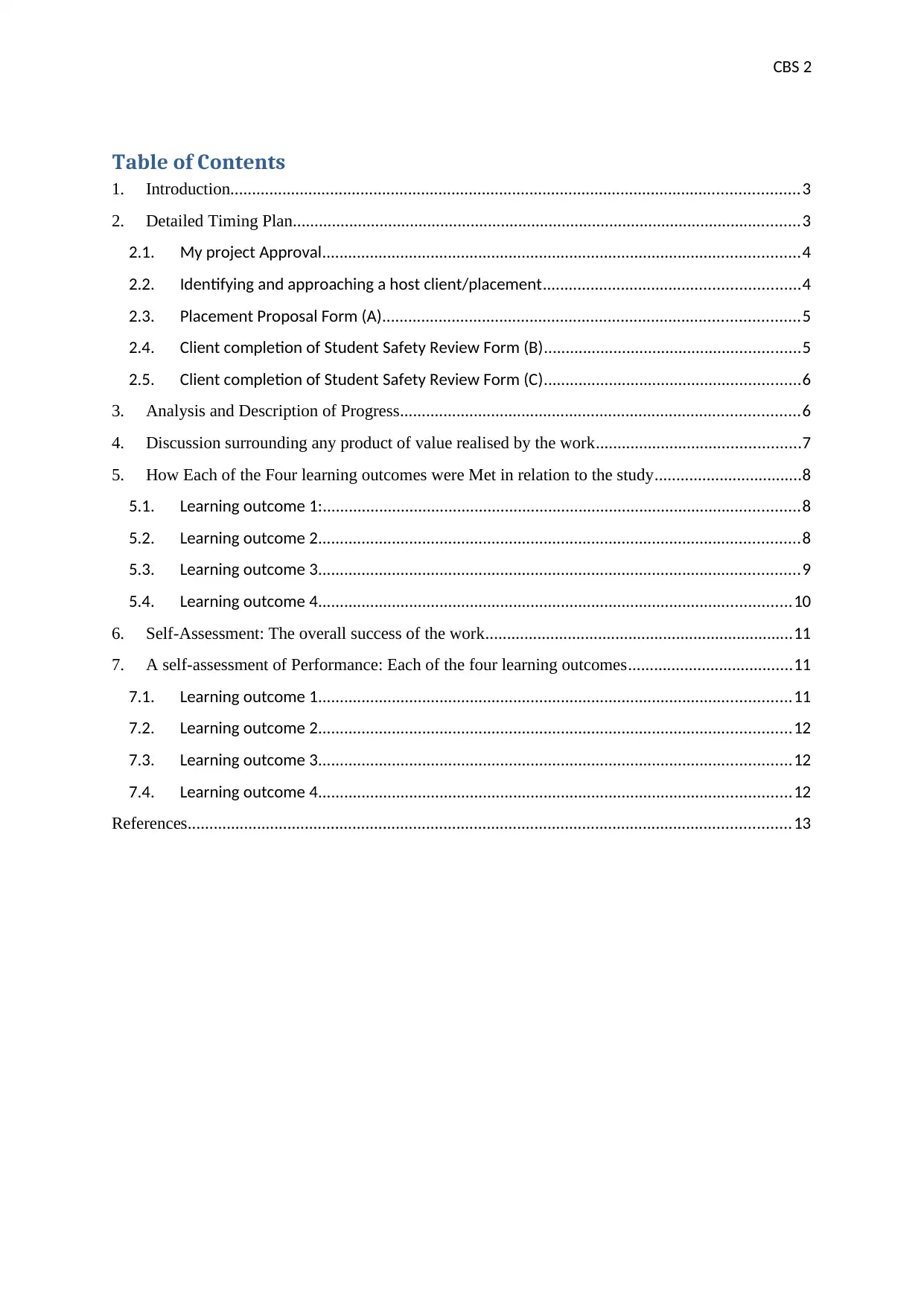
CBS 2
Table of Contents
1. Introduction...................................................................................................................................3
2. Detailed Timing Plan.....................................................................................................................3
2.1. My project Approval..............................................................................................................4
2.2. Identifying and approaching a host client/placement...........................................................4
2.3. Placement Proposal Form (A)................................................................................................5
2.4. Client completion of Student Safety Review Form (B)...........................................................5
2.5. Client completion of Student Safety Review Form (C)...........................................................6
3. Analysis and Description of Progress............................................................................................6
4. Discussion surrounding any product of value realised by the work...............................................7
5. How Each of the Four learning outcomes were Met in relation to the study..................................8
5.1. Learning outcome 1:..............................................................................................................8
5.2. Learning outcome 2...............................................................................................................8
5.3. Learning outcome 3...............................................................................................................9
5.4. Learning outcome 4.............................................................................................................10
6. Self-Assessment: The overall success of the work.......................................................................11
7. A self-assessment of Performance: Each of the four learning outcomes......................................11
7.1. Learning outcome 1.............................................................................................................11
7.2. Learning outcome 2.............................................................................................................12
7.3. Learning outcome 3.............................................................................................................12
7.4. Learning outcome 4.............................................................................................................12
References...........................................................................................................................................13
Table of Contents
1. Introduction...................................................................................................................................3
2. Detailed Timing Plan.....................................................................................................................3
2.1. My project Approval..............................................................................................................4
2.2. Identifying and approaching a host client/placement...........................................................4
2.3. Placement Proposal Form (A)................................................................................................5
2.4. Client completion of Student Safety Review Form (B)...........................................................5
2.5. Client completion of Student Safety Review Form (C)...........................................................6
3. Analysis and Description of Progress............................................................................................6
4. Discussion surrounding any product of value realised by the work...............................................7
5. How Each of the Four learning outcomes were Met in relation to the study..................................8
5.1. Learning outcome 1:..............................................................................................................8
5.2. Learning outcome 2...............................................................................................................8
5.3. Learning outcome 3...............................................................................................................9
5.4. Learning outcome 4.............................................................................................................10
6. Self-Assessment: The overall success of the work.......................................................................11
7. A self-assessment of Performance: Each of the four learning outcomes......................................11
7.1. Learning outcome 1.............................................................................................................11
7.2. Learning outcome 2.............................................................................................................12
7.3. Learning outcome 3.............................................................................................................12
7.4. Learning outcome 4.............................................................................................................12
References...........................................................................................................................................13
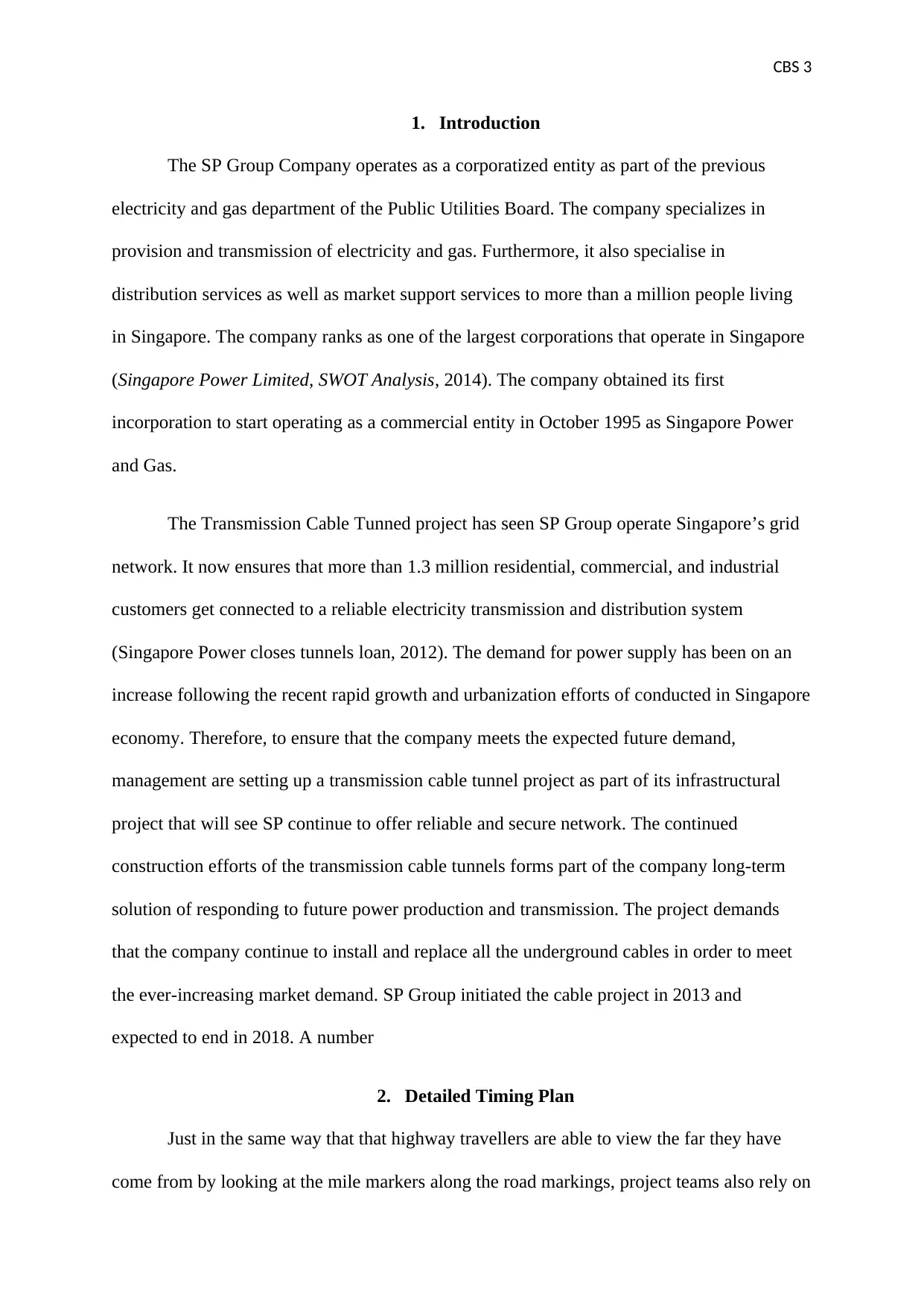
CBS 3
1. Introduction
The SP Group Company operates as a corporatized entity as part of the previous
electricity and gas department of the Public Utilities Board. The company specializes in
provision and transmission of electricity and gas. Furthermore, it also specialise in
distribution services as well as market support services to more than a million people living
in Singapore. The company ranks as one of the largest corporations that operate in Singapore
(Singapore Power Limited, SWOT Analysis, 2014). The company obtained its first
incorporation to start operating as a commercial entity in October 1995 as Singapore Power
and Gas.
The Transmission Cable Tunned project has seen SP Group operate Singapore’s grid
network. It now ensures that more than 1.3 million residential, commercial, and industrial
customers get connected to a reliable electricity transmission and distribution system
(Singapore Power closes tunnels loan, 2012). The demand for power supply has been on an
increase following the recent rapid growth and urbanization efforts of conducted in Singapore
economy. Therefore, to ensure that the company meets the expected future demand,
management are setting up a transmission cable tunnel project as part of its infrastructural
project that will see SP continue to offer reliable and secure network. The continued
construction efforts of the transmission cable tunnels forms part of the company long-term
solution of responding to future power production and transmission. The project demands
that the company continue to install and replace all the underground cables in order to meet
the ever-increasing market demand. SP Group initiated the cable project in 2013 and
expected to end in 2018. A number
2. Detailed Timing Plan
Just in the same way that that highway travellers are able to view the far they have
come from by looking at the mile markers along the road markings, project teams also rely on
1. Introduction
The SP Group Company operates as a corporatized entity as part of the previous
electricity and gas department of the Public Utilities Board. The company specializes in
provision and transmission of electricity and gas. Furthermore, it also specialise in
distribution services as well as market support services to more than a million people living
in Singapore. The company ranks as one of the largest corporations that operate in Singapore
(Singapore Power Limited, SWOT Analysis, 2014). The company obtained its first
incorporation to start operating as a commercial entity in October 1995 as Singapore Power
and Gas.
The Transmission Cable Tunned project has seen SP Group operate Singapore’s grid
network. It now ensures that more than 1.3 million residential, commercial, and industrial
customers get connected to a reliable electricity transmission and distribution system
(Singapore Power closes tunnels loan, 2012). The demand for power supply has been on an
increase following the recent rapid growth and urbanization efforts of conducted in Singapore
economy. Therefore, to ensure that the company meets the expected future demand,
management are setting up a transmission cable tunnel project as part of its infrastructural
project that will see SP continue to offer reliable and secure network. The continued
construction efforts of the transmission cable tunnels forms part of the company long-term
solution of responding to future power production and transmission. The project demands
that the company continue to install and replace all the underground cables in order to meet
the ever-increasing market demand. SP Group initiated the cable project in 2013 and
expected to end in 2018. A number
2. Detailed Timing Plan
Just in the same way that that highway travellers are able to view the far they have
come from by looking at the mile markers along the road markings, project teams also rely on
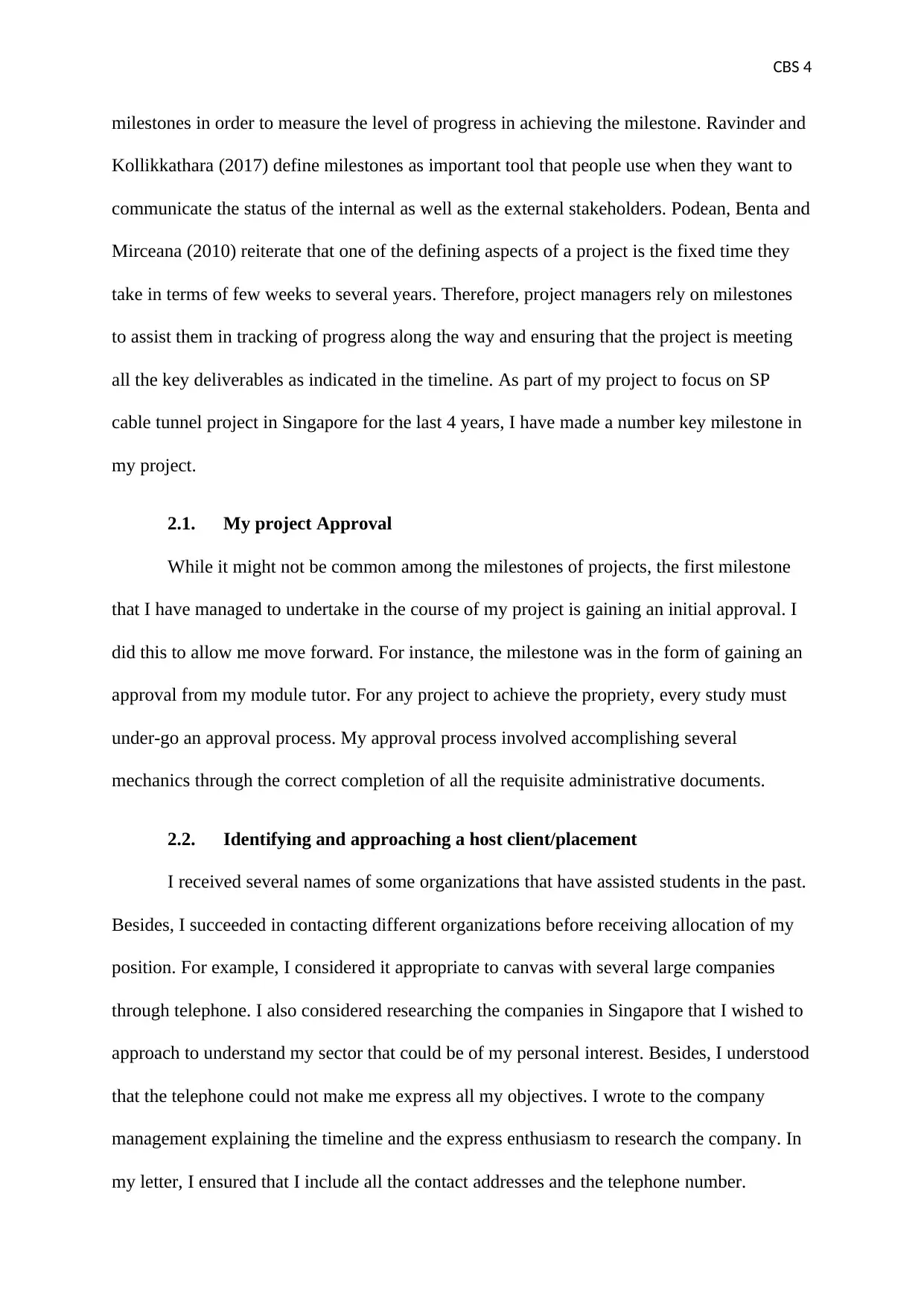
CBS 4
milestones in order to measure the level of progress in achieving the milestone. Ravinder and
Kollikkathara (2017) define milestones as important tool that people use when they want to
communicate the status of the internal as well as the external stakeholders. Podean, Benta and
Mirceana (2010) reiterate that one of the defining aspects of a project is the fixed time they
take in terms of few weeks to several years. Therefore, project managers rely on milestones
to assist them in tracking of progress along the way and ensuring that the project is meeting
all the key deliverables as indicated in the timeline. As part of my project to focus on SP
cable tunnel project in Singapore for the last 4 years, I have made a number key milestone in
my project.
2.1. My project Approval
While it might not be common among the milestones of projects, the first milestone
that I have managed to undertake in the course of my project is gaining an initial approval. I
did this to allow me move forward. For instance, the milestone was in the form of gaining an
approval from my module tutor. For any project to achieve the propriety, every study must
under-go an approval process. My approval process involved accomplishing several
mechanics through the correct completion of all the requisite administrative documents.
2.2. Identifying and approaching a host client/placement
I received several names of some organizations that have assisted students in the past.
Besides, I succeeded in contacting different organizations before receiving allocation of my
position. For example, I considered it appropriate to canvas with several large companies
through telephone. I also considered researching the companies in Singapore that I wished to
approach to understand my sector that could be of my personal interest. Besides, I understood
that the telephone could not make me express all my objectives. I wrote to the company
management explaining the timeline and the express enthusiasm to research the company. In
my letter, I ensured that I include all the contact addresses and the telephone number.
milestones in order to measure the level of progress in achieving the milestone. Ravinder and
Kollikkathara (2017) define milestones as important tool that people use when they want to
communicate the status of the internal as well as the external stakeholders. Podean, Benta and
Mirceana (2010) reiterate that one of the defining aspects of a project is the fixed time they
take in terms of few weeks to several years. Therefore, project managers rely on milestones
to assist them in tracking of progress along the way and ensuring that the project is meeting
all the key deliverables as indicated in the timeline. As part of my project to focus on SP
cable tunnel project in Singapore for the last 4 years, I have made a number key milestone in
my project.
2.1. My project Approval
While it might not be common among the milestones of projects, the first milestone
that I have managed to undertake in the course of my project is gaining an initial approval. I
did this to allow me move forward. For instance, the milestone was in the form of gaining an
approval from my module tutor. For any project to achieve the propriety, every study must
under-go an approval process. My approval process involved accomplishing several
mechanics through the correct completion of all the requisite administrative documents.
2.2. Identifying and approaching a host client/placement
I received several names of some organizations that have assisted students in the past.
Besides, I succeeded in contacting different organizations before receiving allocation of my
position. For example, I considered it appropriate to canvas with several large companies
through telephone. I also considered researching the companies in Singapore that I wished to
approach to understand my sector that could be of my personal interest. Besides, I understood
that the telephone could not make me express all my objectives. I wrote to the company
management explaining the timeline and the express enthusiasm to research the company. In
my letter, I ensured that I include all the contact addresses and the telephone number.
Secure Best Marks with AI Grader
Need help grading? Try our AI Grader for instant feedback on your assignments.
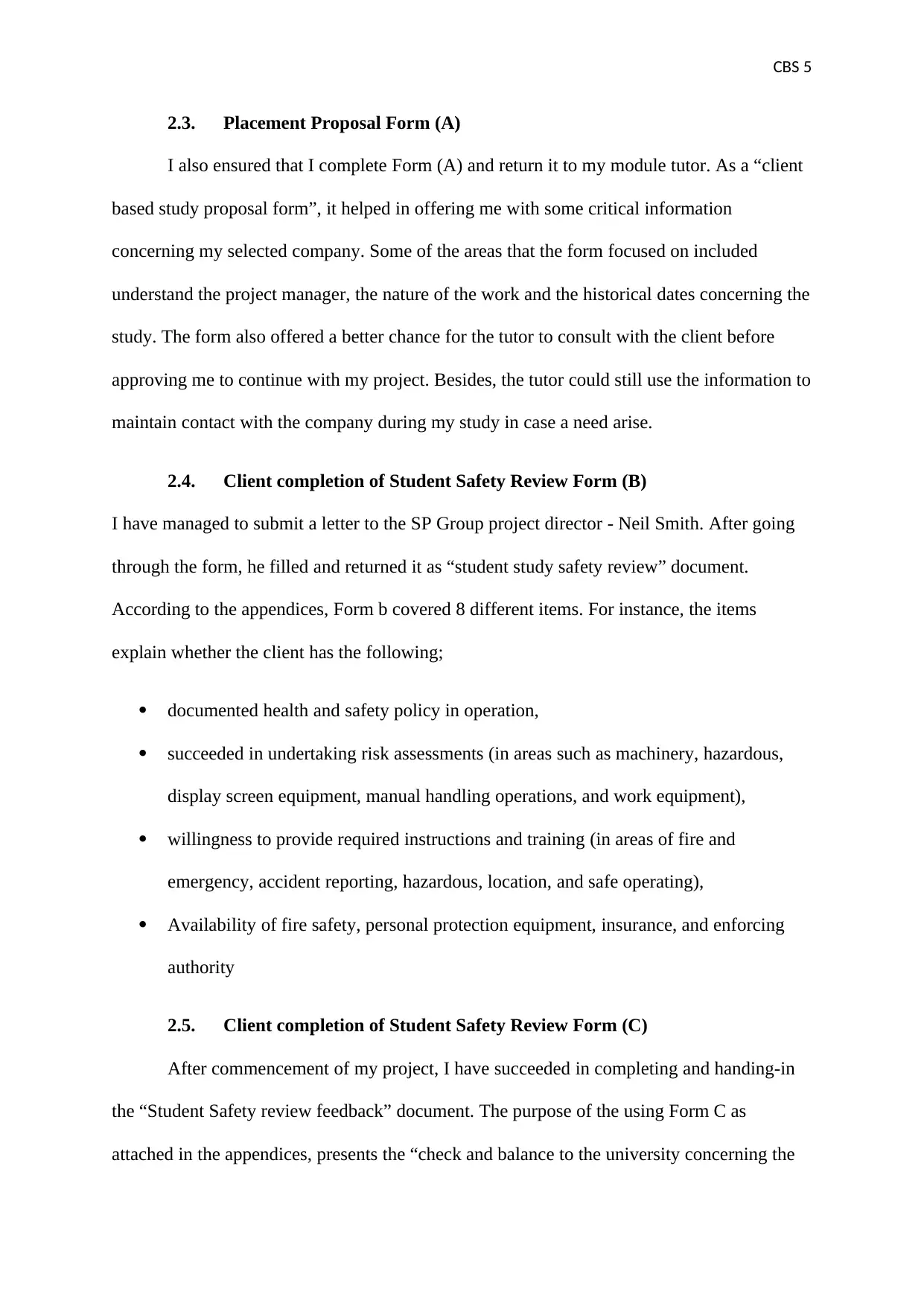
CBS 5
2.3. Placement Proposal Form (A)
I also ensured that I complete Form (A) and return it to my module tutor. As a “client
based study proposal form”, it helped in offering me with some critical information
concerning my selected company. Some of the areas that the form focused on included
understand the project manager, the nature of the work and the historical dates concerning the
study. The form also offered a better chance for the tutor to consult with the client before
approving me to continue with my project. Besides, the tutor could still use the information to
maintain contact with the company during my study in case a need arise.
2.4. Client completion of Student Safety Review Form (B)
I have managed to submit a letter to the SP Group project director - Neil Smith. After going
through the form, he filled and returned it as “student study safety review” document.
According to the appendices, Form b covered 8 different items. For instance, the items
explain whether the client has the following;
documented health and safety policy in operation,
succeeded in undertaking risk assessments (in areas such as machinery, hazardous,
display screen equipment, manual handling operations, and work equipment),
willingness to provide required instructions and training (in areas of fire and
emergency, accident reporting, hazardous, location, and safe operating),
Availability of fire safety, personal protection equipment, insurance, and enforcing
authority
2.5. Client completion of Student Safety Review Form (C)
After commencement of my project, I have succeeded in completing and handing-in
the “Student Safety review feedback” document. The purpose of the using Form C as
attached in the appendices, presents the “check and balance to the university concerning the
2.3. Placement Proposal Form (A)
I also ensured that I complete Form (A) and return it to my module tutor. As a “client
based study proposal form”, it helped in offering me with some critical information
concerning my selected company. Some of the areas that the form focused on included
understand the project manager, the nature of the work and the historical dates concerning the
study. The form also offered a better chance for the tutor to consult with the client before
approving me to continue with my project. Besides, the tutor could still use the information to
maintain contact with the company during my study in case a need arise.
2.4. Client completion of Student Safety Review Form (B)
I have managed to submit a letter to the SP Group project director - Neil Smith. After going
through the form, he filled and returned it as “student study safety review” document.
According to the appendices, Form b covered 8 different items. For instance, the items
explain whether the client has the following;
documented health and safety policy in operation,
succeeded in undertaking risk assessments (in areas such as machinery, hazardous,
display screen equipment, manual handling operations, and work equipment),
willingness to provide required instructions and training (in areas of fire and
emergency, accident reporting, hazardous, location, and safe operating),
Availability of fire safety, personal protection equipment, insurance, and enforcing
authority
2.5. Client completion of Student Safety Review Form (C)
After commencement of my project, I have succeeded in completing and handing-in
the “Student Safety review feedback” document. The purpose of the using Form C as
attached in the appendices, presents the “check and balance to the university concerning the
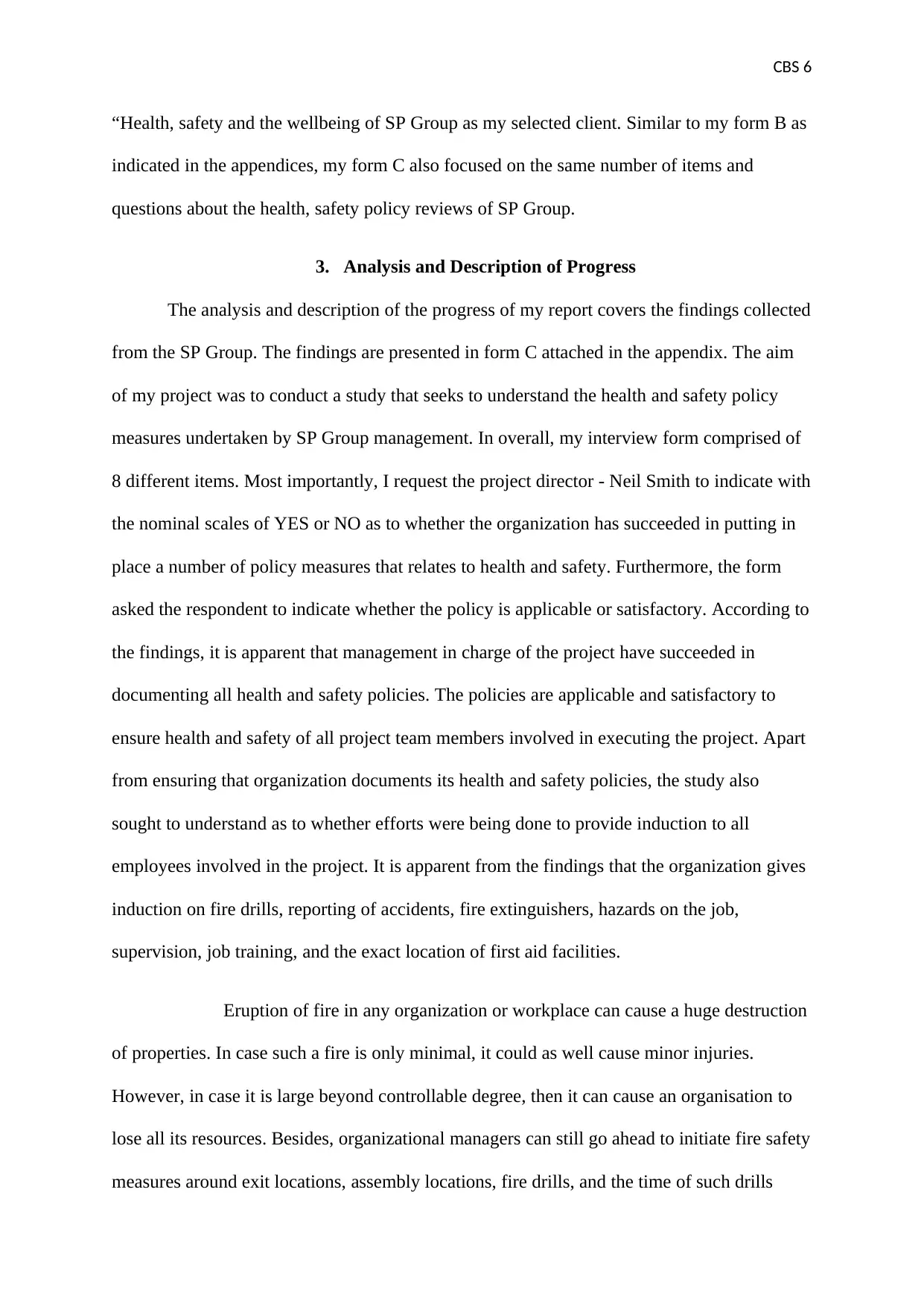
CBS 6
“Health, safety and the wellbeing of SP Group as my selected client. Similar to my form B as
indicated in the appendices, my form C also focused on the same number of items and
questions about the health, safety policy reviews of SP Group.
3. Analysis and Description of Progress
The analysis and description of the progress of my report covers the findings collected
from the SP Group. The findings are presented in form C attached in the appendix. The aim
of my project was to conduct a study that seeks to understand the health and safety policy
measures undertaken by SP Group management. In overall, my interview form comprised of
8 different items. Most importantly, I request the project director - Neil Smith to indicate with
the nominal scales of YES or NO as to whether the organization has succeeded in putting in
place a number of policy measures that relates to health and safety. Furthermore, the form
asked the respondent to indicate whether the policy is applicable or satisfactory. According to
the findings, it is apparent that management in charge of the project have succeeded in
documenting all health and safety policies. The policies are applicable and satisfactory to
ensure health and safety of all project team members involved in executing the project. Apart
from ensuring that organization documents its health and safety policies, the study also
sought to understand as to whether efforts were being done to provide induction to all
employees involved in the project. It is apparent from the findings that the organization gives
induction on fire drills, reporting of accidents, fire extinguishers, hazards on the job,
supervision, job training, and the exact location of first aid facilities.
Eruption of fire in any organization or workplace can cause a huge destruction
of properties. In case such a fire is only minimal, it could as well cause minor injuries.
However, in case it is large beyond controllable degree, then it can cause an organisation to
lose all its resources. Besides, organizational managers can still go ahead to initiate fire safety
measures around exit locations, assembly locations, fire drills, and the time of such drills
“Health, safety and the wellbeing of SP Group as my selected client. Similar to my form B as
indicated in the appendices, my form C also focused on the same number of items and
questions about the health, safety policy reviews of SP Group.
3. Analysis and Description of Progress
The analysis and description of the progress of my report covers the findings collected
from the SP Group. The findings are presented in form C attached in the appendix. The aim
of my project was to conduct a study that seeks to understand the health and safety policy
measures undertaken by SP Group management. In overall, my interview form comprised of
8 different items. Most importantly, I request the project director - Neil Smith to indicate with
the nominal scales of YES or NO as to whether the organization has succeeded in putting in
place a number of policy measures that relates to health and safety. Furthermore, the form
asked the respondent to indicate whether the policy is applicable or satisfactory. According to
the findings, it is apparent that management in charge of the project have succeeded in
documenting all health and safety policies. The policies are applicable and satisfactory to
ensure health and safety of all project team members involved in executing the project. Apart
from ensuring that organization documents its health and safety policies, the study also
sought to understand as to whether efforts were being done to provide induction to all
employees involved in the project. It is apparent from the findings that the organization gives
induction on fire drills, reporting of accidents, fire extinguishers, hazards on the job,
supervision, job training, and the exact location of first aid facilities.
Eruption of fire in any organization or workplace can cause a huge destruction
of properties. In case such a fire is only minimal, it could as well cause minor injuries.
However, in case it is large beyond controllable degree, then it can cause an organisation to
lose all its resources. Besides, organizational managers can still go ahead to initiate fire safety
measures around exit locations, assembly locations, fire drills, and the time of such drills
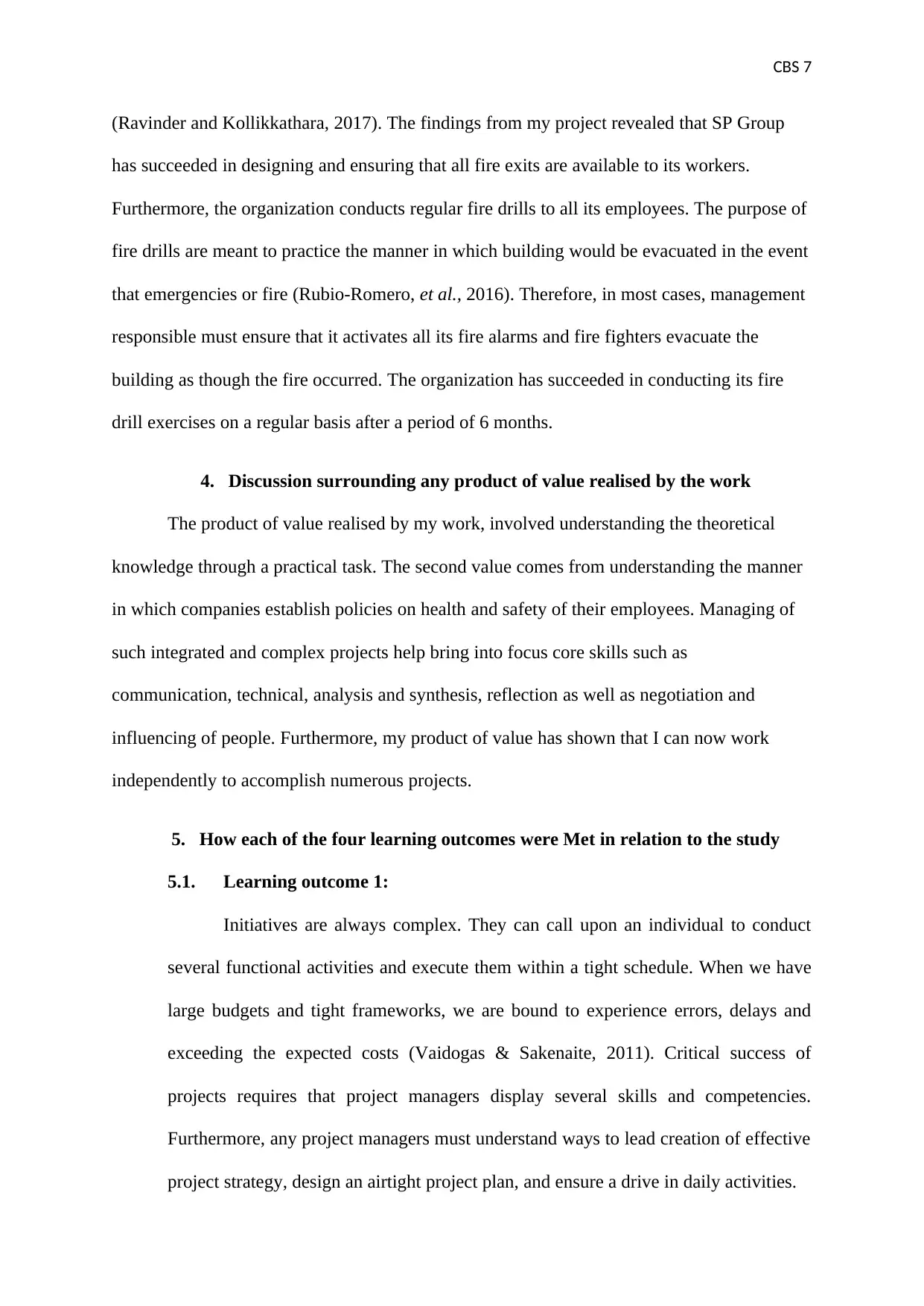
CBS 7
(Ravinder and Kollikkathara, 2017). The findings from my project revealed that SP Group
has succeeded in designing and ensuring that all fire exits are available to its workers.
Furthermore, the organization conducts regular fire drills to all its employees. The purpose of
fire drills are meant to practice the manner in which building would be evacuated in the event
that emergencies or fire (Rubio-Romero, et al., 2016). Therefore, in most cases, management
responsible must ensure that it activates all its fire alarms and fire fighters evacuate the
building as though the fire occurred. The organization has succeeded in conducting its fire
drill exercises on a regular basis after a period of 6 months.
4. Discussion surrounding any product of value realised by the work
The product of value realised by my work, involved understanding the theoretical
knowledge through a practical task. The second value comes from understanding the manner
in which companies establish policies on health and safety of their employees. Managing of
such integrated and complex projects help bring into focus core skills such as
communication, technical, analysis and synthesis, reflection as well as negotiation and
influencing of people. Furthermore, my product of value has shown that I can now work
independently to accomplish numerous projects.
5. How each of the four learning outcomes were Met in relation to the study
5.1. Learning outcome 1:
Initiatives are always complex. They can call upon an individual to conduct
several functional activities and execute them within a tight schedule. When we have
large budgets and tight frameworks, we are bound to experience errors, delays and
exceeding the expected costs (Vaidogas & Sakenaite, 2011). Critical success of
projects requires that project managers display several skills and competencies.
Furthermore, any project managers must understand ways to lead creation of effective
project strategy, design an airtight project plan, and ensure a drive in daily activities.
(Ravinder and Kollikkathara, 2017). The findings from my project revealed that SP Group
has succeeded in designing and ensuring that all fire exits are available to its workers.
Furthermore, the organization conducts regular fire drills to all its employees. The purpose of
fire drills are meant to practice the manner in which building would be evacuated in the event
that emergencies or fire (Rubio-Romero, et al., 2016). Therefore, in most cases, management
responsible must ensure that it activates all its fire alarms and fire fighters evacuate the
building as though the fire occurred. The organization has succeeded in conducting its fire
drill exercises on a regular basis after a period of 6 months.
4. Discussion surrounding any product of value realised by the work
The product of value realised by my work, involved understanding the theoretical
knowledge through a practical task. The second value comes from understanding the manner
in which companies establish policies on health and safety of their employees. Managing of
such integrated and complex projects help bring into focus core skills such as
communication, technical, analysis and synthesis, reflection as well as negotiation and
influencing of people. Furthermore, my product of value has shown that I can now work
independently to accomplish numerous projects.
5. How each of the four learning outcomes were Met in relation to the study
5.1. Learning outcome 1:
Initiatives are always complex. They can call upon an individual to conduct
several functional activities and execute them within a tight schedule. When we have
large budgets and tight frameworks, we are bound to experience errors, delays and
exceeding the expected costs (Vaidogas & Sakenaite, 2011). Critical success of
projects requires that project managers display several skills and competencies.
Furthermore, any project managers must understand ways to lead creation of effective
project strategy, design an airtight project plan, and ensure a drive in daily activities.
Paraphrase This Document
Need a fresh take? Get an instant paraphrase of this document with our AI Paraphraser
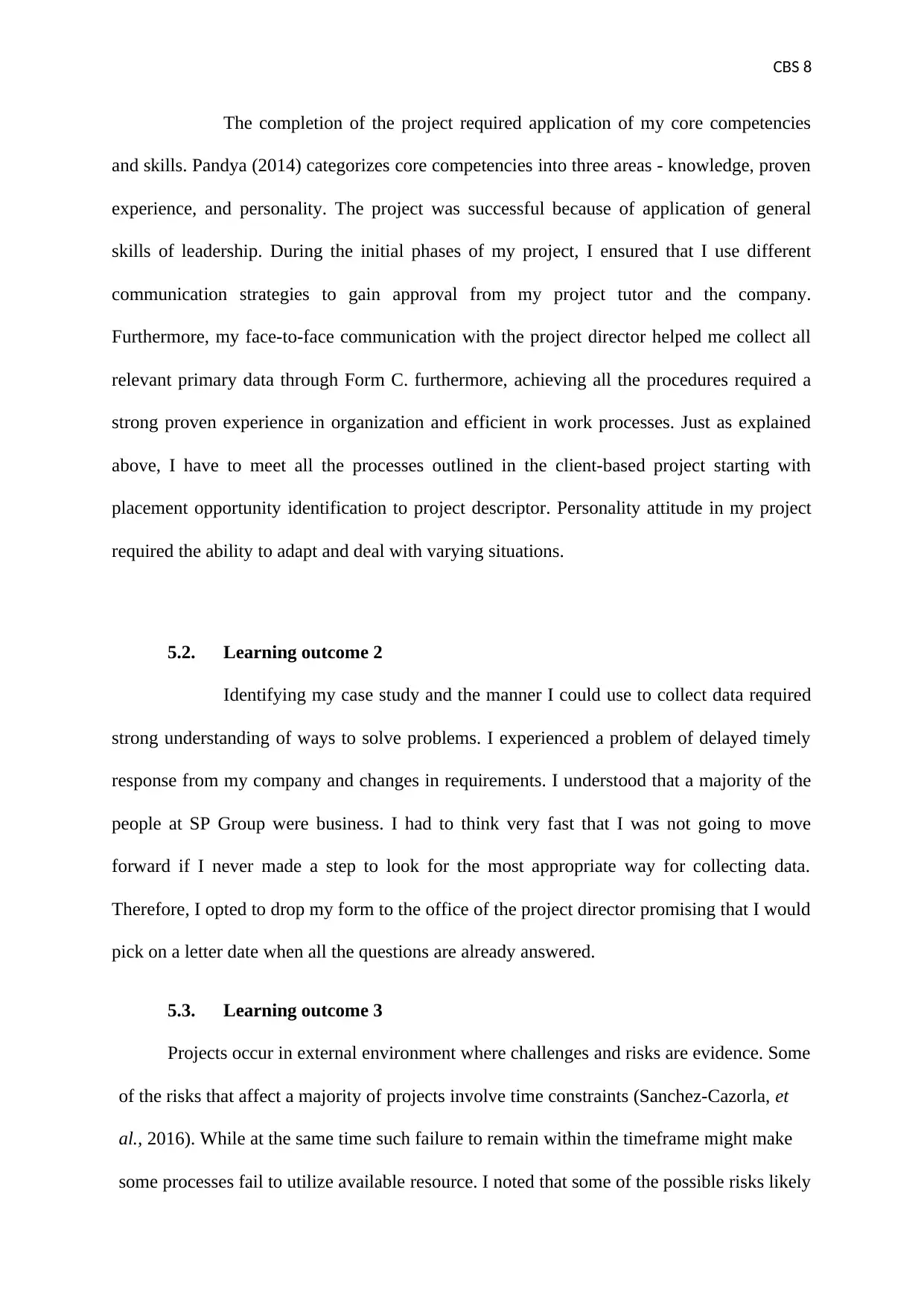
CBS 8
The completion of the project required application of my core competencies
and skills. Pandya (2014) categorizes core competencies into three areas - knowledge, proven
experience, and personality. The project was successful because of application of general
skills of leadership. During the initial phases of my project, I ensured that I use different
communication strategies to gain approval from my project tutor and the company.
Furthermore, my face-to-face communication with the project director helped me collect all
relevant primary data through Form C. furthermore, achieving all the procedures required a
strong proven experience in organization and efficient in work processes. Just as explained
above, I have to meet all the processes outlined in the client-based project starting with
placement opportunity identification to project descriptor. Personality attitude in my project
required the ability to adapt and deal with varying situations.
5.2. Learning outcome 2
Identifying my case study and the manner I could use to collect data required
strong understanding of ways to solve problems. I experienced a problem of delayed timely
response from my company and changes in requirements. I understood that a majority of the
people at SP Group were business. I had to think very fast that I was not going to move
forward if I never made a step to look for the most appropriate way for collecting data.
Therefore, I opted to drop my form to the office of the project director promising that I would
pick on a letter date when all the questions are already answered.
5.3. Learning outcome 3
Projects occur in external environment where challenges and risks are evidence. Some
of the risks that affect a majority of projects involve time constraints (Sanchez-Cazorla, et
al., 2016). While at the same time such failure to remain within the timeframe might make
some processes fail to utilize available resource. I noted that some of the possible risks likely
The completion of the project required application of my core competencies
and skills. Pandya (2014) categorizes core competencies into three areas - knowledge, proven
experience, and personality. The project was successful because of application of general
skills of leadership. During the initial phases of my project, I ensured that I use different
communication strategies to gain approval from my project tutor and the company.
Furthermore, my face-to-face communication with the project director helped me collect all
relevant primary data through Form C. furthermore, achieving all the procedures required a
strong proven experience in organization and efficient in work processes. Just as explained
above, I have to meet all the processes outlined in the client-based project starting with
placement opportunity identification to project descriptor. Personality attitude in my project
required the ability to adapt and deal with varying situations.
5.2. Learning outcome 2
Identifying my case study and the manner I could use to collect data required
strong understanding of ways to solve problems. I experienced a problem of delayed timely
response from my company and changes in requirements. I understood that a majority of the
people at SP Group were business. I had to think very fast that I was not going to move
forward if I never made a step to look for the most appropriate way for collecting data.
Therefore, I opted to drop my form to the office of the project director promising that I would
pick on a letter date when all the questions are already answered.
5.3. Learning outcome 3
Projects occur in external environment where challenges and risks are evidence. Some
of the risks that affect a majority of projects involve time constraints (Sanchez-Cazorla, et
al., 2016). While at the same time such failure to remain within the timeframe might make
some processes fail to utilize available resource. I noted that some of the possible risks likely
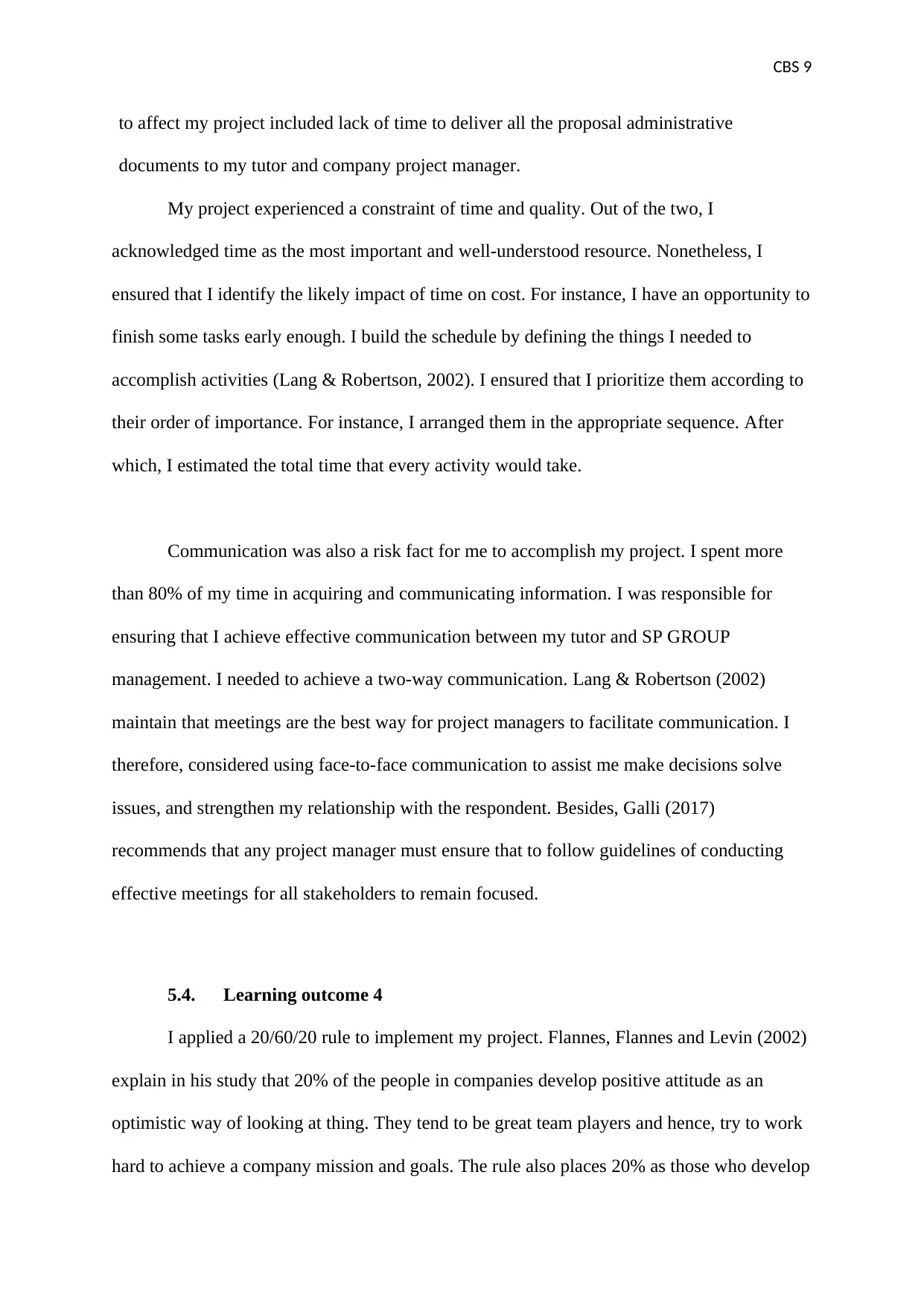
CBS 9
to affect my project included lack of time to deliver all the proposal administrative
documents to my tutor and company project manager.
My project experienced a constraint of time and quality. Out of the two, I
acknowledged time as the most important and well-understood resource. Nonetheless, I
ensured that I identify the likely impact of time on cost. For instance, I have an opportunity to
finish some tasks early enough. I build the schedule by defining the things I needed to
accomplish activities (Lang & Robertson, 2002). I ensured that I prioritize them according to
their order of importance. For instance, I arranged them in the appropriate sequence. After
which, I estimated the total time that every activity would take.
Communication was also a risk fact for me to accomplish my project. I spent more
than 80% of my time in acquiring and communicating information. I was responsible for
ensuring that I achieve effective communication between my tutor and SP GROUP
management. I needed to achieve a two-way communication. Lang & Robertson (2002)
maintain that meetings are the best way for project managers to facilitate communication. I
therefore, considered using face-to-face communication to assist me make decisions solve
issues, and strengthen my relationship with the respondent. Besides, Galli (2017)
recommends that any project manager must ensure that to follow guidelines of conducting
effective meetings for all stakeholders to remain focused.
5.4. Learning outcome 4
I applied a 20/60/20 rule to implement my project. Flannes, Flannes and Levin (2002)
explain in his study that 20% of the people in companies develop positive attitude as an
optimistic way of looking at thing. They tend to be great team players and hence, try to work
hard to achieve a company mission and goals. The rule also places 20% as those who develop
to affect my project included lack of time to deliver all the proposal administrative
documents to my tutor and company project manager.
My project experienced a constraint of time and quality. Out of the two, I
acknowledged time as the most important and well-understood resource. Nonetheless, I
ensured that I identify the likely impact of time on cost. For instance, I have an opportunity to
finish some tasks early enough. I build the schedule by defining the things I needed to
accomplish activities (Lang & Robertson, 2002). I ensured that I prioritize them according to
their order of importance. For instance, I arranged them in the appropriate sequence. After
which, I estimated the total time that every activity would take.
Communication was also a risk fact for me to accomplish my project. I spent more
than 80% of my time in acquiring and communicating information. I was responsible for
ensuring that I achieve effective communication between my tutor and SP GROUP
management. I needed to achieve a two-way communication. Lang & Robertson (2002)
maintain that meetings are the best way for project managers to facilitate communication. I
therefore, considered using face-to-face communication to assist me make decisions solve
issues, and strengthen my relationship with the respondent. Besides, Galli (2017)
recommends that any project manager must ensure that to follow guidelines of conducting
effective meetings for all stakeholders to remain focused.
5.4. Learning outcome 4
I applied a 20/60/20 rule to implement my project. Flannes, Flannes and Levin (2002)
explain in his study that 20% of the people in companies develop positive attitude as an
optimistic way of looking at thing. They tend to be great team players and hence, try to work
hard to achieve a company mission and goals. The rule also places 20% as those who develop
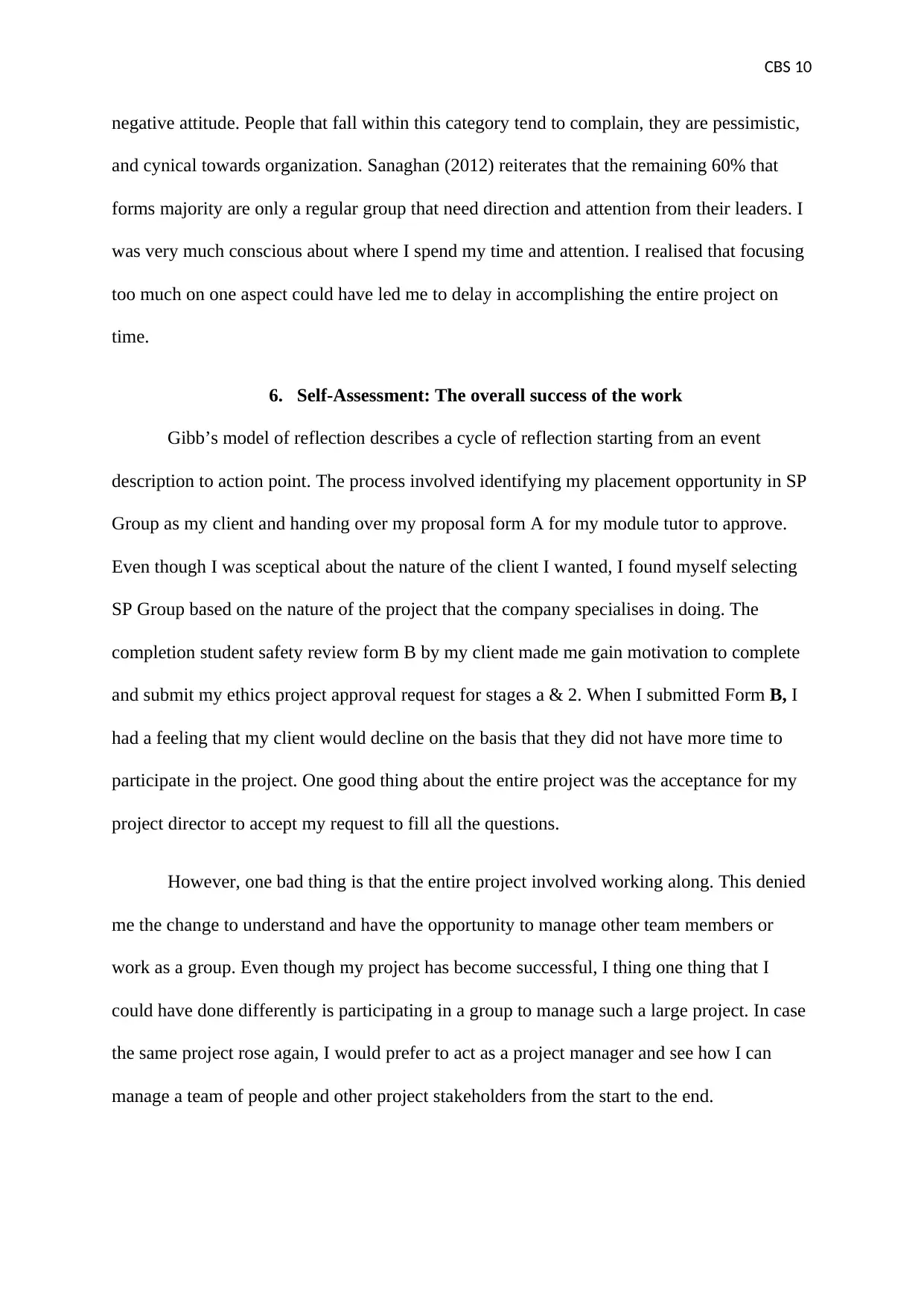
CBS 10
negative attitude. People that fall within this category tend to complain, they are pessimistic,
and cynical towards organization. Sanaghan (2012) reiterates that the remaining 60% that
forms majority are only a regular group that need direction and attention from their leaders. I
was very much conscious about where I spend my time and attention. I realised that focusing
too much on one aspect could have led me to delay in accomplishing the entire project on
time.
6. Self-Assessment: The overall success of the work
Gibb’s model of reflection describes a cycle of reflection starting from an event
description to action point. The process involved identifying my placement opportunity in SP
Group as my client and handing over my proposal form A for my module tutor to approve.
Even though I was sceptical about the nature of the client I wanted, I found myself selecting
SP Group based on the nature of the project that the company specialises in doing. The
completion student safety review form B by my client made me gain motivation to complete
and submit my ethics project approval request for stages a & 2. When I submitted Form B, I
had a feeling that my client would decline on the basis that they did not have more time to
participate in the project. One good thing about the entire project was the acceptance for my
project director to accept my request to fill all the questions.
However, one bad thing is that the entire project involved working along. This denied
me the change to understand and have the opportunity to manage other team members or
work as a group. Even though my project has become successful, I thing one thing that I
could have done differently is participating in a group to manage such a large project. In case
the same project rose again, I would prefer to act as a project manager and see how I can
manage a team of people and other project stakeholders from the start to the end.
negative attitude. People that fall within this category tend to complain, they are pessimistic,
and cynical towards organization. Sanaghan (2012) reiterates that the remaining 60% that
forms majority are only a regular group that need direction and attention from their leaders. I
was very much conscious about where I spend my time and attention. I realised that focusing
too much on one aspect could have led me to delay in accomplishing the entire project on
time.
6. Self-Assessment: The overall success of the work
Gibb’s model of reflection describes a cycle of reflection starting from an event
description to action point. The process involved identifying my placement opportunity in SP
Group as my client and handing over my proposal form A for my module tutor to approve.
Even though I was sceptical about the nature of the client I wanted, I found myself selecting
SP Group based on the nature of the project that the company specialises in doing. The
completion student safety review form B by my client made me gain motivation to complete
and submit my ethics project approval request for stages a & 2. When I submitted Form B, I
had a feeling that my client would decline on the basis that they did not have more time to
participate in the project. One good thing about the entire project was the acceptance for my
project director to accept my request to fill all the questions.
However, one bad thing is that the entire project involved working along. This denied
me the change to understand and have the opportunity to manage other team members or
work as a group. Even though my project has become successful, I thing one thing that I
could have done differently is participating in a group to manage such a large project. In case
the same project rose again, I would prefer to act as a project manager and see how I can
manage a team of people and other project stakeholders from the start to the end.
Secure Best Marks with AI Grader
Need help grading? Try our AI Grader for instant feedback on your assignments.
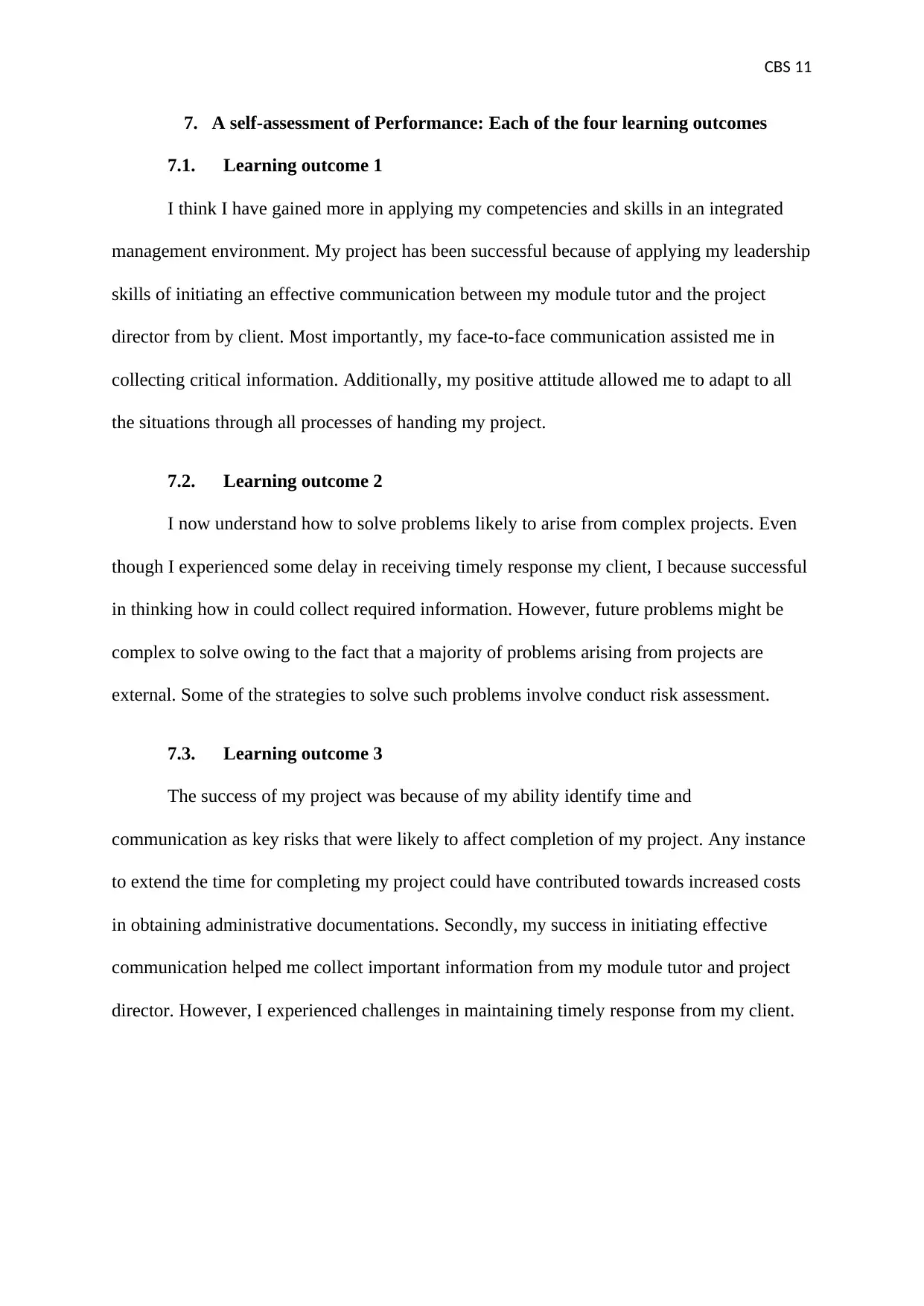
CBS 11
7. A self-assessment of Performance: Each of the four learning outcomes
7.1. Learning outcome 1
I think I have gained more in applying my competencies and skills in an integrated
management environment. My project has been successful because of applying my leadership
skills of initiating an effective communication between my module tutor and the project
director from by client. Most importantly, my face-to-face communication assisted me in
collecting critical information. Additionally, my positive attitude allowed me to adapt to all
the situations through all processes of handing my project.
7.2. Learning outcome 2
I now understand how to solve problems likely to arise from complex projects. Even
though I experienced some delay in receiving timely response my client, I because successful
in thinking how in could collect required information. However, future problems might be
complex to solve owing to the fact that a majority of problems arising from projects are
external. Some of the strategies to solve such problems involve conduct risk assessment.
7.3. Learning outcome 3
The success of my project was because of my ability identify time and
communication as key risks that were likely to affect completion of my project. Any instance
to extend the time for completing my project could have contributed towards increased costs
in obtaining administrative documentations. Secondly, my success in initiating effective
communication helped me collect important information from my module tutor and project
director. However, I experienced challenges in maintaining timely response from my client.
7. A self-assessment of Performance: Each of the four learning outcomes
7.1. Learning outcome 1
I think I have gained more in applying my competencies and skills in an integrated
management environment. My project has been successful because of applying my leadership
skills of initiating an effective communication between my module tutor and the project
director from by client. Most importantly, my face-to-face communication assisted me in
collecting critical information. Additionally, my positive attitude allowed me to adapt to all
the situations through all processes of handing my project.
7.2. Learning outcome 2
I now understand how to solve problems likely to arise from complex projects. Even
though I experienced some delay in receiving timely response my client, I because successful
in thinking how in could collect required information. However, future problems might be
complex to solve owing to the fact that a majority of problems arising from projects are
external. Some of the strategies to solve such problems involve conduct risk assessment.
7.3. Learning outcome 3
The success of my project was because of my ability identify time and
communication as key risks that were likely to affect completion of my project. Any instance
to extend the time for completing my project could have contributed towards increased costs
in obtaining administrative documentations. Secondly, my success in initiating effective
communication helped me collect important information from my module tutor and project
director. However, I experienced challenges in maintaining timely response from my client.
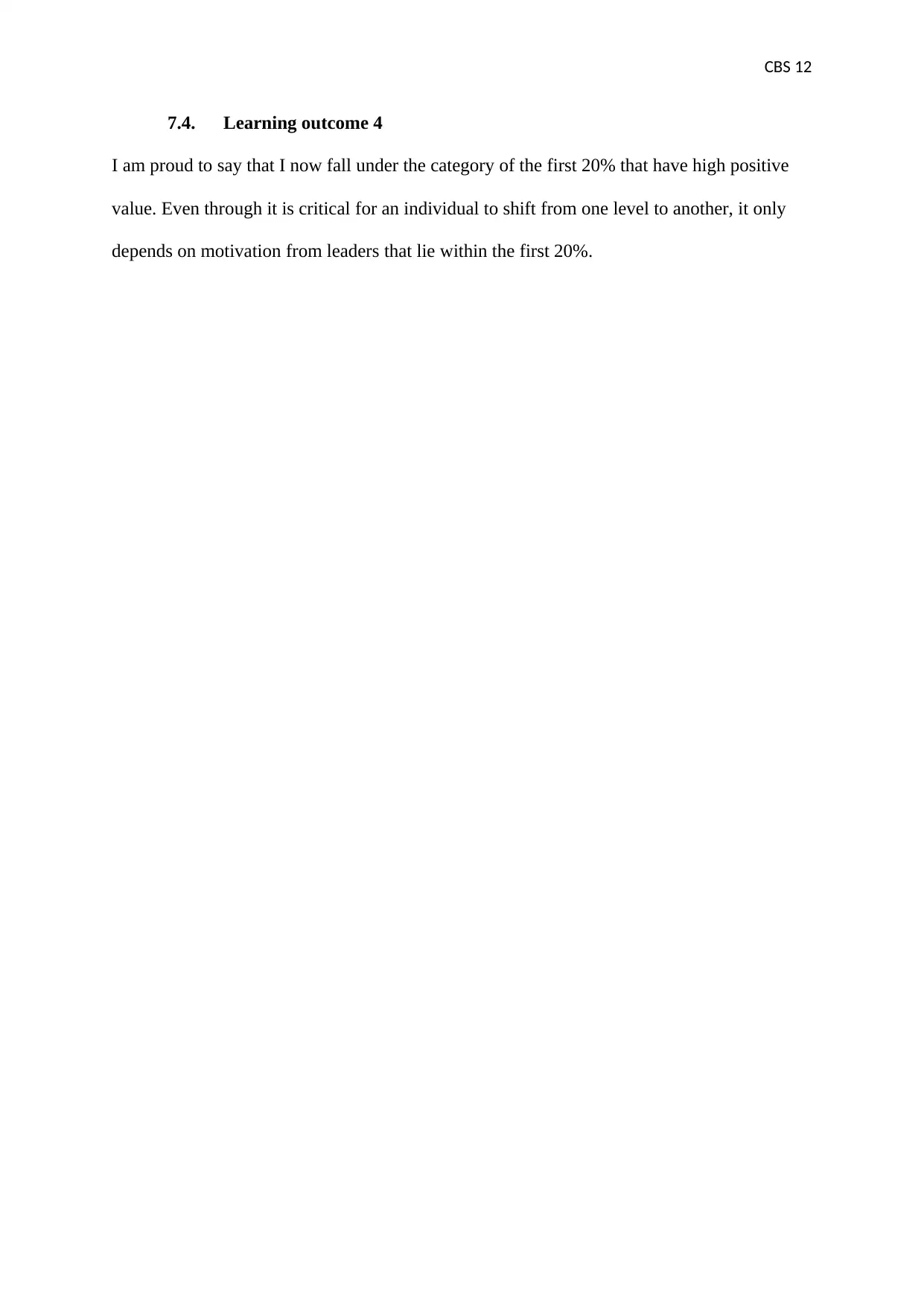
CBS 12
7.4. Learning outcome 4
I am proud to say that I now fall under the category of the first 20% that have high positive
value. Even through it is critical for an individual to shift from one level to another, it only
depends on motivation from leaders that lie within the first 20%.
7.4. Learning outcome 4
I am proud to say that I now fall under the category of the first 20% that have high positive
value. Even through it is critical for an individual to shift from one level to another, it only
depends on motivation from leaders that lie within the first 20%.
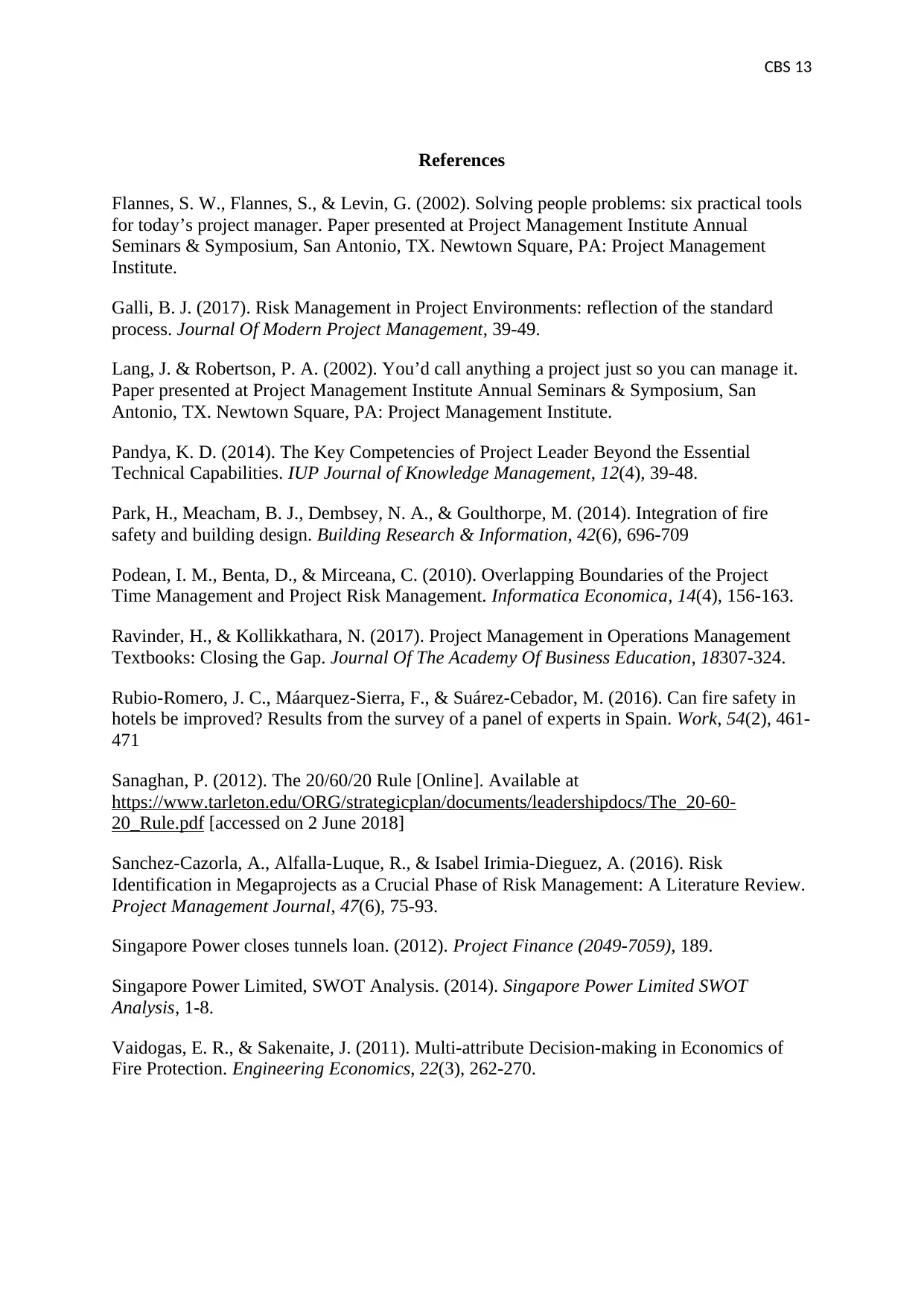
CBS 13
References
Flannes, S. W., Flannes, S., & Levin, G. (2002). Solving people problems: six practical tools
for today’s project manager. Paper presented at Project Management Institute Annual
Seminars & Symposium, San Antonio, TX. Newtown Square, PA: Project Management
Institute.
Galli, B. J. (2017). Risk Management in Project Environments: reflection of the standard
process. Journal Of Modern Project Management, 39-49.
Lang, J. & Robertson, P. A. (2002). You’d call anything a project just so you can manage it.
Paper presented at Project Management Institute Annual Seminars & Symposium, San
Antonio, TX. Newtown Square, PA: Project Management Institute.
Pandya, K. D. (2014). The Key Competencies of Project Leader Beyond the Essential
Technical Capabilities. IUP Journal of Knowledge Management, 12(4), 39-48.
Park, H., Meacham, B. J., Dembsey, N. A., & Goulthorpe, M. (2014). Integration of fire
safety and building design. Building Research & Information, 42(6), 696-709
Podean, I. M., Benta, D., & Mirceana, C. (2010). Overlapping Boundaries of the Project
Time Management and Project Risk Management. Informatica Economica, 14(4), 156-163.
Ravinder, H., & Kollikkathara, N. (2017). Project Management in Operations Management
Textbooks: Closing the Gap. Journal Of The Academy Of Business Education, 18307-324.
Rubio-Romero, J. C., Máarquez-Sierra, F., & Suárez-Cebador, M. (2016). Can fire safety in
hotels be improved? Results from the survey of a panel of experts in Spain. Work, 54(2), 461-
471
Sanaghan, P. (2012). The 20/60/20 Rule [Online]. Available at
https://www.tarleton.edu/ORG/strategicplan/documents/leadershipdocs/The_20-60-
20_Rule.pdf [accessed on 2 June 2018]
Sanchez-Cazorla, A., Alfalla-Luque, R., & Isabel Irimia-Dieguez, A. (2016). Risk
Identification in Megaprojects as a Crucial Phase of Risk Management: A Literature Review.
Project Management Journal, 47(6), 75-93.
Singapore Power closes tunnels loan. (2012). Project Finance (2049-7059), 189.
Singapore Power Limited, SWOT Analysis. (2014). Singapore Power Limited SWOT
Analysis, 1-8.
Vaidogas, E. R., & Sakenaite, J. (2011). Multi-attribute Decision-making in Economics of
Fire Protection. Engineering Economics, 22(3), 262-270.
References
Flannes, S. W., Flannes, S., & Levin, G. (2002). Solving people problems: six practical tools
for today’s project manager. Paper presented at Project Management Institute Annual
Seminars & Symposium, San Antonio, TX. Newtown Square, PA: Project Management
Institute.
Galli, B. J. (2017). Risk Management in Project Environments: reflection of the standard
process. Journal Of Modern Project Management, 39-49.
Lang, J. & Robertson, P. A. (2002). You’d call anything a project just so you can manage it.
Paper presented at Project Management Institute Annual Seminars & Symposium, San
Antonio, TX. Newtown Square, PA: Project Management Institute.
Pandya, K. D. (2014). The Key Competencies of Project Leader Beyond the Essential
Technical Capabilities. IUP Journal of Knowledge Management, 12(4), 39-48.
Park, H., Meacham, B. J., Dembsey, N. A., & Goulthorpe, M. (2014). Integration of fire
safety and building design. Building Research & Information, 42(6), 696-709
Podean, I. M., Benta, D., & Mirceana, C. (2010). Overlapping Boundaries of the Project
Time Management and Project Risk Management. Informatica Economica, 14(4), 156-163.
Ravinder, H., & Kollikkathara, N. (2017). Project Management in Operations Management
Textbooks: Closing the Gap. Journal Of The Academy Of Business Education, 18307-324.
Rubio-Romero, J. C., Máarquez-Sierra, F., & Suárez-Cebador, M. (2016). Can fire safety in
hotels be improved? Results from the survey of a panel of experts in Spain. Work, 54(2), 461-
471
Sanaghan, P. (2012). The 20/60/20 Rule [Online]. Available at
https://www.tarleton.edu/ORG/strategicplan/documents/leadershipdocs/The_20-60-
20_Rule.pdf [accessed on 2 June 2018]
Sanchez-Cazorla, A., Alfalla-Luque, R., & Isabel Irimia-Dieguez, A. (2016). Risk
Identification in Megaprojects as a Crucial Phase of Risk Management: A Literature Review.
Project Management Journal, 47(6), 75-93.
Singapore Power closes tunnels loan. (2012). Project Finance (2049-7059), 189.
Singapore Power Limited, SWOT Analysis. (2014). Singapore Power Limited SWOT
Analysis, 1-8.
Vaidogas, E. R., & Sakenaite, J. (2011). Multi-attribute Decision-making in Economics of
Fire Protection. Engineering Economics, 22(3), 262-270.
1 out of 13
Related Documents
Your All-in-One AI-Powered Toolkit for Academic Success.
+13062052269
info@desklib.com
Available 24*7 on WhatsApp / Email
![[object Object]](/_next/static/media/star-bottom.7253800d.svg)
Unlock your academic potential
© 2024 | Zucol Services PVT LTD | All rights reserved.




